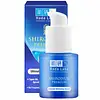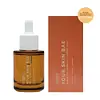What's inside
What's inside
 Key Ingredients
Key Ingredients

 Benefits
Benefits

 Concerns
Concerns

No concerns
 Ingredients Side-by-side
Ingredients Side-by-side

Water
Skin ConditioningButylene Glycol
HumectantTranexamic Acid
AstringentPentylene Glycol
Skin ConditioningGlycolic Acid
BufferingSqualane
EmollientHydroxyethyl Acrylate/Sodium Acryloyldimethyl Taurate Copolymer
Emulsion StabilisingGlycol Distearate
EmollientC14-22 Alcohols
Emulsion StabilisingPhenoxyethanol
PreservativePEG-60 Hydrogenated Castor Oil
EmulsifyingSodium Hyaluronate
HumectantSucrose
HumectantHydroxyethylcellulose
Emulsion StabilisingC12-20 Alkyl Glucoside
EmulsifyingArginine
MaskingDisodium EDTA
PEG-8
HumectantGlycerin
HumectantBetaine
HumectantXanthan Gum
EmulsifyingSorbitan Isostearate
EmulsifyingPolysorbate 60
EmulsifyingSpirulina Maxima Extract
SmoothingEthylhexyl Stearate
EmollientBeta-Glucan
Skin ConditioningCaprylyl Glycol
EmollientSodium Phosphate
BufferingLecithin
EmollientTocopheryl Acetate
AntioxidantCeramide Ng
Skin ConditioningSodium Hyaluronate Crosspolymer
HumectantPolyglyceryl-4 Diisostearate/Polyhydroxystearate/Sebacate
EmulsifyingSodium Isostearate
CleansingNonapeptide-1
Skin ConditioningSodium Acetylated Hyaluronate
HumectantHydrolyzed Hyaluronic Acid
HumectantHydrolyzed Sodium Hyaluronate
Skin ConditioningMagnesium Ascorbyl Phosphate
AntioxidantGardenia Jasminoides Fruit Extract
Cosmetic ColorantMaltodextrin
AbsorbentDisodium Phosphate
BufferingWater, Butylene Glycol, Tranexamic Acid, Pentylene Glycol, Glycolic Acid, Squalane, Hydroxyethyl Acrylate/Sodium Acryloyldimethyl Taurate Copolymer, Glycol Distearate, C14-22 Alcohols, Phenoxyethanol, PEG-60 Hydrogenated Castor Oil, Sodium Hyaluronate, Sucrose, Hydroxyethylcellulose, C12-20 Alkyl Glucoside, Arginine, Disodium EDTA, PEG-8, Glycerin, Betaine, Xanthan Gum, Sorbitan Isostearate, Polysorbate 60, Spirulina Maxima Extract, Ethylhexyl Stearate, Beta-Glucan, Caprylyl Glycol, Sodium Phosphate, Lecithin, Tocopheryl Acetate, Ceramide Ng, Sodium Hyaluronate Crosspolymer, Polyglyceryl-4 Diisostearate/Polyhydroxystearate/Sebacate, Sodium Isostearate, Nonapeptide-1, Sodium Acetylated Hyaluronate, Hydrolyzed Hyaluronic Acid, Hydrolyzed Sodium Hyaluronate, Magnesium Ascorbyl Phosphate, Gardenia Jasminoides Fruit Extract, Maltodextrin, Disodium Phosphate
Ingredients Explained
These ingredients are found in both products.
Ingredients higher up in an ingredient list are typically present in a larger amount.
Butylene Glycol (or BG) is used within cosmetic products for a few different reasons:
Overall, Butylene Glycol is a safe and well-rounded ingredient that works well with other ingredients.
Though this ingredient works well with most skin types, some people with sensitive skin may experience a reaction such as allergic rashes, closed comedones, or itchiness.
Learn more about Butylene GlycolDisodium EDTA plays a role in making products more stable by aiding other preservatives.
It is a chelating agent, meaning it neutralizes metal ions that may be found in a product.
Disodium EDTA is a salt of edetic acid and is found to be safe in cosmetic ingredients.
Learn more about Disodium EDTAGlycerin is already naturally found in your skin. It helps moisturize and protect your skin.
A study from 2016 found glycerin to be more effective as a humectant than AHAs and hyaluronic acid.
As a humectant, it helps the skin stay hydrated by pulling moisture to your skin. The low molecular weight of glycerin allows it to pull moisture into the deeper layers of your skin.
Hydrated skin improves your skin barrier; Your skin barrier helps protect against irritants and bacteria.
Glycerin has also been found to have antimicrobial and antiviral properties. Due to these properties, glycerin is often used in wound and burn treatments.
In cosmetics, glycerin is usually derived from plants such as soybean or palm. However, it can also be sourced from animals, such as tallow or animal fat.
This ingredient is organic, colorless, odorless, and non-toxic.
Glycerin is the name for this ingredient in American English. British English uses Glycerol/Glycerine.
Learn more about GlycerinHydroxyethylcellulose is used to improve the texture of products. It is created from a chemical reaction involving ethylene oxide and alkali-cellulose. Cellulose is a sugar found in plant cell walls and help give plants structure.
This ingredient helps stabilize products by preventing ingredients from separating. It can also help thicken the texture of a product.
This ingredient can also be found in pill medicines to help our bodies digest other ingredients.
Learn more about HydroxyethylcellulosePhenoxyethanol is a preservative that has germicide, antimicrobial, and aromatic properties. Studies show that phenoxyethanol can prevent microbial growth. By itself, it has a scent that is similar to that of a rose.
It's often used in formulations along with Caprylyl Glycol to preserve the shelf life of products.
Water. It's the most common cosmetic ingredient of all. You'll usually see it at the top of ingredient lists, meaning that it makes up the largest part of the product.
So why is it so popular? Water most often acts as a solvent - this means that it helps dissolve other ingredients into the formulation.
You'll also recognize water as that liquid we all need to stay alive. If you see this, drink a glass of water. Stay hydrated!
Learn more about Water